Lowrance Active Target 1 vs 2 (Key Differences Explained)
UPDATED 03 NOVEMBER 2023
by Robert Ceran
This article may contain affiliate links. If you make a purchase after clicking on a link we may earn a small commission at no extra cost to you.
Are you wondering how good the new Lowrance Active Target 2 is, and if it’s worth upgrading your existing Active Target system to the new version?
In that case, it’s essential to understand what distinguishes ActiveTarget 2 from the original ActiveTarget 1.
For this article my team and I tested the Active Target vs Active Target 2 transducers side by side, and I’ll go over the results of our testing. I’ll also cover their main differences, and will also discuss whether it’s worth getting the new Active Target 2 or not.
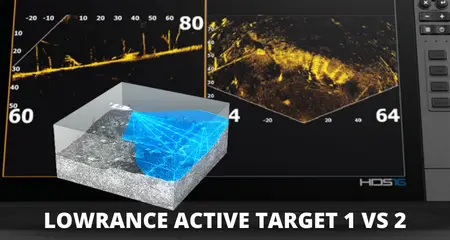
What is the difference between Lowrance Active Target vs Active Target 2?
The main difference between Lowrance Active Target 1 and 2 is that while Active Target 1 has 3 sonar views, Active Target 2 comes with 3 additional sonar views (making 6 in total).
Active Target 2 achieves this by enabling you to combine sonar data from two Active Target transducers onto a single HDS Pro display unit.
This functionality allows you to cover a larger area with live sonar, thus getting a much wider view with Active Target 2 than with the original version of Lowrance’s live sonar.
In addition to this new feature, Active Target 2 also comes with slightly better resolution and more detailed imaging than the original version.
Now let’s dive into the details and compare these two versions of Lowrance’s live sonar side by side.
Lowrance Active Target 1 vs 2 – key features compared
The table above compares the key features of Lowrance Active Target 2 vs Active Target based on our testing.
Let’s examine the differences and similarities between these two versions of Lowrance’s forward facing sonar in more detail.
Additional sonar views
This is the area with the biggest difference between the two versions of Active Target.
The original Active Target comes with 3 different sonar views: forward, down, and scout view (see image below):
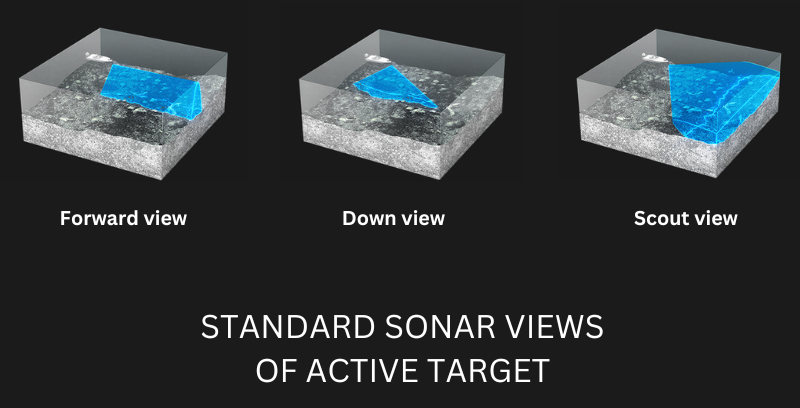
In contrast to this, the new Active Target 2 not has the same 3 sonar views, but also comes with 3 additional views: Scout & Forward, Scout Wide, and 180 view (see image below):
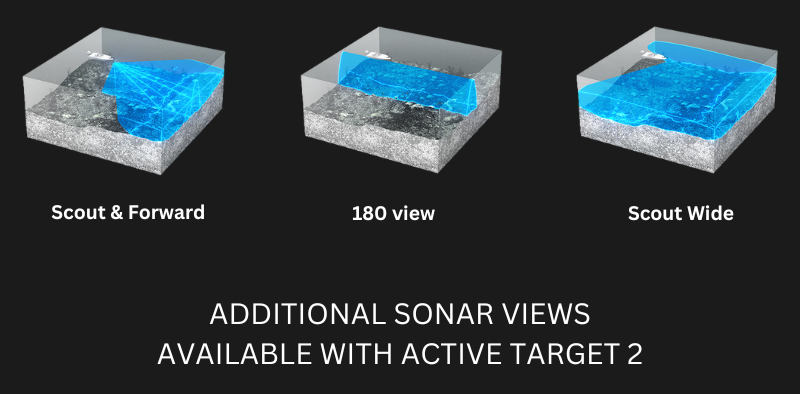
Based on our tests, this is an amazing upgrade to the Active Target live imaging system, and provides much wider views for finding and catching fish.
In fact, Scout Wide view comes impressively close to being the first sonar that combines live sonar with 360 imaging into one powerful tool.
Also, 180 view is currently the only live sonar system that allows you to switch between forward and down view without having to physically rotate your transducer, which was extremely helpful during our tests.
However, in order to use the additional sonar views of ActiveTarget 2, you do need to have two Active Target 2 transducers that are correctly mounted to complement each other’s viewing angle.
In addition to having two transducers, you also need to have an HDS Pro console unit to display the sonar data (since the previous generations of HDS units are not able to do this), which obviously comes at a substantial additional cost.
Finally, if you want to use the Scout Wide view, you’ll need to get a special mounting bracket designed specifically to position two Active Target transducers correctly for this view.
Target resolution & image quality
Lowrance has also improved the resolution of its live sonar system with the new version, and during our testing we found that this is especially noticeable when looking at objects and fish that are at a long distance from your boat or ice fishing hole.
The new Active Target 2 also comes with fewer problems than the original version, as Lowrance have been busy addressing the weaknesses of the first generation.
This improvement has further strengthened the position of Lowrance’s Active Target 2 as the best live sonar for long range imaging.
Compatibility
While the original Active Target is compatible with any HDS Live, HDS Carbon, or Elite FS unit, the new version is compatible with the same units, but in addition it is also compatible with the newly released HDS Pro.
Pricing
As far as pricing goes, Active Target 2 currently retails at the same price as the original version.
However, keep in mind that you’ll need two Active Target 2 transducers if you want to take advantage of the three new sonar views offered by it, which means you’ll have to double the cost.
Also, the new sonar views are only available when using HDS Pro (which is the latest version of the Lowrance HDS console unit), which means you’ll have to upgrade your display unit as well as your transducer.
Finally, if you want to use the wide scout view, you’ll also need to get a scout wide bracket for mounting your Active Target transducer, which retails at around $80.
Lowrance ActiveTarget 1 overview
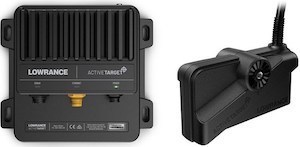

The original Active Target live sonar system was released in 2020 as Lowrance’s answer to Garmin’s LiveScope, which had dominated the market of live sonar in recreational fishing up to that point.
This live imaging system comes with 3 different sonar views, including forward mode, down mode, and scout mode. Scout mode is the same as perspective mode on LiveScope.
Overall, Active Target has successfully challenged LiveScope as the dominant live sonar on the market, and it is especially attractive for anglers who want to run an all-Lowrance boat.
In addition to this, our testing shows that it provides the best long range live imaging performance, allowing you to clearly visualize your lure or small fish at a greater distance from the boat.
Lowrance Active Target 2 review
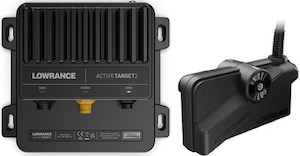

While the Lowrance Active Target 2 transducers looks almost identical to the old version, it comes with several key features that set it apart from the first generation.
Most notably, you can combine sonar data from two Active Target 2 transducers on one display if you’re using the HDS Pro control head.
During testing we found that this allows you to cover a much wider area of water with live sonar, and especially the Scout Wide view is very close to providing live sonar with 360 coverage.
Is Active Target 2 worth it?
If you don’t have any Active Target live sonar yet, then it’s definitely worth getting the new version of Lowrance’s live sonar.
However, if you already have Active Target 1, you may want to think twice before investing the additional money to get access to the advantages offered by Active Target 2.
The reason for this is that you’ll not only have to buy two Active Target 2 transducers to get the additional sonar views that it provides, but you’ll also have to upgrade your Lowrance display unit to HDS Pro.
Since some anglers feel that this is prohibitively expensive, they are choosing to wait until it’s time to replace their current Active Target 1 and/or HDS unit before upgrading to the new version.
Gear and methods used for testing
For consistent testing results to compare Lowrance Active Target vs Active Target 2, we tested both of the transducers reviewed above on a MotorGuide Xi5 trolling motor on the bow of a Ranger Z520R bass boat. We tested both transducers on the same day on Lake Tarpon, to make sure we could compare their performance side by side under similar conditions. Testing was performed by imaging schools of bluegill, crappie, and largemouth bass relating to structure in 4 to 19 feet of water.


